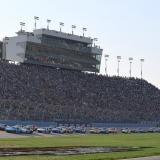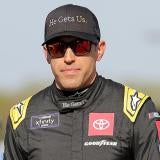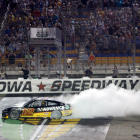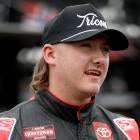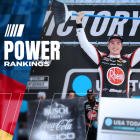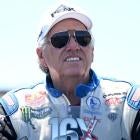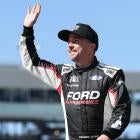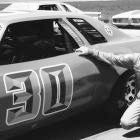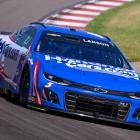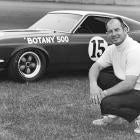
"If you build it, they will come," Iowans thought when NASCAR Hall of Famer Rusty Wallace built a state-of-the-art racetrack that first hosted stock car competition in 2006.
Turns out the slogan was, "if you build it, you will wait."
It took 18 years for a Cup Series race to find its way to the 7/8-mile oval, a short(ish) track with unique characteristics not found anywhere else on the circuit. Along the way, the track found itself sold to NASCAR itself, which slowly removed even some of its top feeder divisions from Iowa's future plans by the end of the 2019 season.
The low point came three years ago, when only the ARCA Series raced on a track that had become virtually dormant. But NASCAR's top brass always claimed they bought Iowa for a reason: to one day revamp it and make it part of their long-term future to diversify the schedule.
In just three years, a plan spearheaded by Bill France Jr.'s grandson, Ben Kennedy, has come to fruition. There's been a return of sponsorship, enthusiasm and even a partial repave that culminated in sold-out grandstands for Sunday night's Iowa Corn 350.
"The crowd tonight was awesome," race winner Ryan Blaney said. "Packed house. [If] that doesn't make you want to come back here, I don't know what will."
Indeed, fans cheered a race that featured a perfect mix of speed, strategy and short track action: three-abreast racing at an oval critics felt would be little more than a one-groove racetrack on newer pavement.
Considering the circumstances, it felt appropriate for Blaney to take the checkered flag here, a track where he's won in both the NASCAR Craftsman Truck and Xfinity series. Over 80 friends and family were also in town as Blaney's mother grew up in Chariton, Iowa, a little over an hour away.
"We'd come up here Christmas every year," Blaney said. "We used to drive here from North Carolina which is a long car ride … my mom grew up here. My grandparents lived here for a long time. I just enjoyed the area as a kid."
He also enjoyed dominating this inaugural event to the tune of a career-high 201 laps led. The reigning champ continued a tradition of Team Penske writing their name in the history books for these things: teammate Joey Logano won the first race on Bristol Dirt in 2021, then the exhibition Clash at the L.A. Coliseum and the first Cup race at World Wide Technology Raceway in 2022.
"Not taking anything away from the No. 22 team," Blaney said. "But I think as a whole company we do a good job of these places we go to for the first time. All of Team Penske, they work really hard to be ahead of the game. I think our sim work and all that stuff is really good. Engineers and crew chiefs are great."
And Penske is well-positioned now in their bid for a third straight title, something an organization hasn't accomplished in Cup during the 16-driver playoff era. Blaney's crew chief Jonathan Hassler was bold enough to pronounce they could be "the team of the summer."
We'll see if Iowa proves the catalyst for their 2024 Field of Dreams.
Traffic Report
Green: Chase Elliott. A third-place Iowa finish gave Elliott a title we haven't heard in a while: Cup points leader. His average finish of 9.1 is also a series best, almost three positions better than his championship-winning season back in 2020 (11.7).
Yellow: Josh Berry. A career-best 32 laps led and a seventh-place finish is a big step forward for this soon-to-be-extinct Stewart-Haas Racing rookie auditioning for 2025. But it's going to take a win for Berry to get over the playoff hump, and a decision for four tires on the final caution cost him too much track position to make up after Blaney got back ahead of him with just two.
Red: Kyle Busch. A faulty water pump proved costly for Busch, whose power steering belt broke the second the team addressed the original mechanical failure. Two DNFs in the last three races have left him on the outside of the playoff bubble looking in by some 31 points.
Speeding Ticket: NASCAR officiating. The key moment of the race came during a Lap 183 caution for Daniel Hemric scraping the wall off Turn 2. At the time, Brad Keselowski was out front, one of a handful of drivers who hadn't yet pit during green-flag stops. Of that group, Ricky Stenhouse Jr. chose not to pit under the yellow, trapping several potential contenders a lap down.
It was such a consequential moment in the race. So why did NASCAR throw it? Hemric continued on without incident, just the latest of what were a half-dozen tire failures that occurred over the course of that green-flag run. In each of the previous incidents, drivers kept their cars from spinning or incurring any serious damage. They darted to pit road, lost a few laps and the race just kept going.
Why was Hemric any different? Judge for yourself and then see why Christopher Bell's crew chief, Adam Stevens, was so upset.
"That was the most ridiculous bullsh*t caution I've ever seen in my life." - @CBellRacing's crew chief Adam Stevens#NASCAR #IowaCorn350
— Tom Bowles (@NASCARBowles) June 17, 2024
Oops!
Blaney's main rival for the win was Kyle Larson, the pole sitter who at one point had a 10-second lead on everyone other than Blaney in Stage 1. Larson went on to win Stage 2, but an aggressive move proved to be his downfall on the restart moments later.
BIG TROUBLE FOR KYLE LARSON.
— NASCAR on NBC (@NASCARonNBC) June 17, 2024
📺 : USA Network | #NASCAR pic.twitter.com/ptwp3jo9vB
It was a three-abreast move that went bad with Daniel Suarez not realizing Larson was clear.
"Honestly, during the race, I was so confused," Suarez said after the race. "I didn't know exactly what happened. I didn't know if I went up or he came down … I'm the one who made contact with the 5, but I felt they were lower than I was expecting."
It was Larson who got the worst of it. While Suarez recovered for a top-10 finish, Larson was 34th, some 36 laps off the pace.
"I guess I could have just not gone to the middle and been more patient, knowing how fast my car was …" Larson said. "Probably ended up biting me … I was not sure if Suarez got loose underneath me or what happened."


